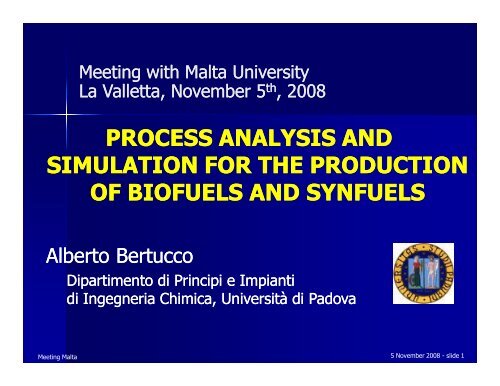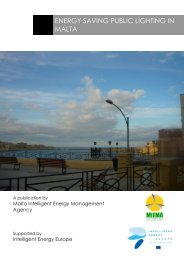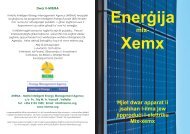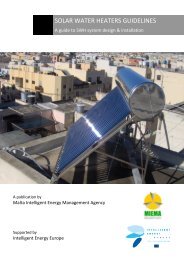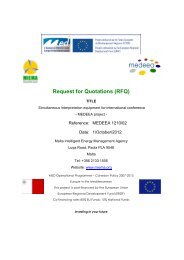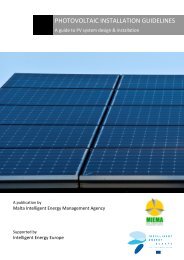Process Analysis and Simulation for the Production of - MIEMA
Process Analysis and Simulation for the Production of - MIEMA
Process Analysis and Simulation for the Production of - MIEMA
Create successful ePaper yourself
Turn your PDF publications into a flip-book with our unique Google optimized e-Paper software.
Meeting Malta<br />
Meeting with Malta University<br />
La Valletta, November 5 th , 2008<br />
PROCESS ANALYSIS AND<br />
SIMULATION FOR THE PRODUCTION<br />
OF BIOFUELS AND SYNFUELS<br />
Alberto Bertucco<br />
Dipartimento di Principi e Impianti<br />
di Ingegneria Chimica, Università di Padova<br />
5 November 2008 - slide 1
Meeting Malta<br />
Definition <strong>of</strong><br />
sustainable development<br />
Humanity has <strong>the</strong> ability<br />
to make development sustainable, i.e.<br />
to ensure that it meets <strong>the</strong> needs <strong>of</strong> <strong>the</strong> present<br />
without compromising <strong>the</strong> ability <strong>of</strong> future<br />
generations to meet <strong>the</strong>ir own needs<br />
(The (The Bruntl<strong>and</strong> Bruntl<strong>and</strong> Report, Report, 1987) 1987)<br />
5 November 2008 - slide 2
Meeting Malta<br />
Where will we find<br />
<strong>the</strong> energy we need?<br />
�� in nuclear reactions<br />
�� in solar radiation<br />
�� in energy savings<br />
�� in renewable sources<br />
5 November 2008 - slide 3
Meeting Malta<br />
Renewable Energy Sources ( (RES RES)<br />
�� WOOD<br />
�� VEGETAL/ANIMAL OILS<br />
�� STARCH/SUGAR<br />
�� WASTES<br />
�� HYDRAULIC POWER<br />
�� WIND POWER<br />
�� GEOTHERMAL POWER<br />
�� OCEANIC WAVES POWER<br />
biomasses<br />
NOTE: hydrogen is NOT an energy source source, , it can be<br />
a tool to store <strong>and</strong> transport energy<br />
5 November 2008 - slide 4
Meeting Malta<br />
RES: solar energy<br />
�� <strong>the</strong> so so-called called “<strong>the</strong>rmal solar”<br />
�� industrial photosyn<strong>the</strong>sis (biomasses)<br />
�� chemical photocatalysis<br />
�� photovoltaic<br />
NOTE: solar energy is a huge amount amount, , yet it is<br />
very diluited (1 kW/m2, at this latitude)<br />
5 November 2008 - slide 5
Meeting Malta<br />
A special problem:<br />
oil <strong>and</strong> transport fuels availability<br />
�� 60% <strong>of</strong> <strong>the</strong> oil produced is consumed as<br />
transportation fuel<br />
�� 98 % <strong>of</strong> transportation fuels is produced<br />
from oil (2% is Natural Gas)<br />
What shall we do without oil?<br />
What will come after oil?<br />
5 November 2008 - slide 6
Meeting Malta<br />
A crucial point: costs,<br />
i.e. economical sustainability<br />
�� The barrel price: what is ahead? (PLOT)<br />
�� Alternatives <strong>for</strong> <strong>the</strong> next 30 years<br />
– SNG, LNG<br />
– Syn<strong>the</strong>tic fuels (GTL, CTL, BTL)<br />
– biodiesel <strong>and</strong> bioethanol<br />
– Biogas, RDF (solido)<br />
– Reduction <strong>of</strong> fuel dem<strong>and</strong><br />
5 November 2008 - slide 7
The The oil price price<br />
spot oil price: historical trend vs. actual price<br />
120,000<br />
historical trend<br />
110,000<br />
actual price<br />
100,000<br />
90,000<br />
80,000<br />
70,000<br />
60,000<br />
50,000<br />
oil price ($/bbl)<br />
40,000<br />
30,000<br />
20,000<br />
10,000<br />
0,000<br />
14/1/09<br />
20/3/08<br />
25/5/07<br />
29/7/06<br />
2/10/05<br />
6/12/04<br />
10/2/04<br />
16/4/03<br />
20/6/02<br />
24/8/01<br />
28/10/00<br />
2/1/00<br />
8/3/99<br />
12/5/98<br />
16/7/97<br />
19/9/96<br />
24/11/95<br />
28/1/95<br />
3/4/94<br />
7/6/93<br />
11/8/92<br />
16/10/91<br />
20/12/90<br />
23/2/90<br />
29/4/89<br />
3/7/88<br />
7/9/87<br />
11/11/86<br />
15/1/86<br />
21/3/85<br />
25/5/84<br />
30/7/83<br />
3/10/82<br />
7/12/81<br />
10/2/81<br />
16/4/80<br />
21/6/79<br />
25/8/78<br />
29/10/77<br />
2/1/77<br />
data<br />
5 November 2008 - slide 8<br />
Meeting Malta
Meeting Malta<br />
<strong>Process</strong>es involved<br />
in alternative fuels production<br />
• Combustion<br />
• Gasification<br />
• Pyrolysis<br />
• Trans-esterification<br />
Trans esterification<br />
• Fermentation<br />
• Re<strong>for</strong>ming<br />
• …<br />
5 November 2008 - slide 9
Meeting Malta<br />
The map <strong>of</strong> bi<strong>of</strong>uels<br />
BIOMASSA<br />
RACCOLTA<br />
TRATTAMENTI<br />
TERMICI<br />
Syngas<br />
SEPARAZIONE E<br />
PRETRATTAMENTO<br />
Zuccheri semplici<br />
Polisaccaridi<br />
• amido<br />
• cellulosa<br />
• emicellulosa<br />
Lignina<br />
Lipidi<br />
Oli di pirolisi<br />
idrocarburi<br />
Alcoli<br />
• etanolo<br />
• butanolo<br />
Idrocarburi ciclici<br />
Acidi grassi e metilesteri<br />
Alcani lineari<br />
Miscele alcoliche, carburanti di sintesi (FT fuels)<br />
Metodi<br />
biochimici<br />
Metodi<br />
termochimici<br />
5 November 2008 - slide 10
Meeting Malta<br />
Bioethanol:<br />
first generation process fundamentals<br />
sugar*<br />
corn*<br />
Fermentation<br />
Raw flour<br />
Recycle <strong>of</strong> H 2O<br />
beer<br />
Distillazione<br />
Milling Dehydration<br />
distillation: stripping <strong>of</strong> alcohol,<br />
fractionation (3-5 columns, at<br />
different pressures)<br />
ethanol >99%<br />
solids<br />
+ H 2O<br />
etanolo >92%<br />
Evaporation<br />
Drying<br />
Animal food<br />
Steam consumption: 2.2-2.8 kg/L EtOH H 2O consumption : ~3 L/L EtOH<br />
5 November 2008 - slide 11
Meeting Malta<br />
The first plant in Italy<br />
(Triera S.p.A., Porto Marghera)<br />
Main features:<br />
maximum productivity: 100.000 t/y<br />
Raw material used: 350.000 t/y<br />
Agricultural l<strong>and</strong>: 30.000 ha<br />
Plant area: 6,5 ha<br />
Investment: 100 million €<br />
Crucial factors<br />
�� raw material available in <strong>the</strong> surroundings<br />
�� close to <strong>the</strong> market<br />
�� Efficient logistics<br />
�� Plant integration<br />
close to <strong>the</strong> market (Refineries (Refineries + + public public transpor transpor fleets) fleets)<br />
5 November 2008 - slide 12
Meeting Malta<br />
<strong>the</strong> “dry milling” process:<br />
Block Flow Diagram (BFD)<br />
steam<br />
water<br />
corn<br />
340 kt/y<br />
Liquefaction SSF<br />
Jet cooking<br />
Mashing<br />
Milling<br />
Distillation<br />
Dehydration<br />
stillage<br />
EtOH >92%<br />
EtOH >99%<br />
110.5 kt/y<br />
CO 2<br />
110 kt/y<br />
Centrifuge<br />
Evaporation<br />
Dry house<br />
DDGS<br />
99.5 kt/y<br />
5 November 2008 - slide 13
Meeting Malta<br />
Ethanol recovery:<br />
an example <strong>of</strong> technical features<br />
from<br />
fermentation<br />
decanter<br />
steam<br />
steam<br />
beer<br />
column<br />
+H2O →<br />
to recycle<br />
stripping<br />
column<br />
to dryhouse<br />
rectifying<br />
column<br />
to recycle<br />
to molecular sieves<br />
5 November 2008 - slide 14
Meeting Malta<br />
Energy duties <strong>of</strong> <strong>the</strong> process:<br />
technological alternatives<br />
� The process requires about 6.5 MWe <strong>of</strong><br />
electricity, 26.6 MW <strong>of</strong> steam, 11 MW <strong>of</strong><br />
<strong>the</strong>rmal power <strong>for</strong> DDGS drying<br />
� Three alternatives were studied, all based<br />
on combined heat <strong>and</strong> power production,<br />
CHP):<br />
Gas turbine<br />
Fuel oil engine<br />
DDGS burner<br />
� The three alternatives were compared to a<br />
base case where steam <strong>and</strong> electricity are<br />
supplied by an external source<br />
5 November 2008 - slide 15
Meeting Malta<br />
CHP: turbina a gas<br />
La stazione CHP a gas naturale è stata progettata per assicurare il<br />
completo fabbisogno di vapore. Il calcolo è stato eseguito sotto le<br />
seguenti ipotesi:<br />
P el (MW) 25.2<br />
η el (%) 34.6<br />
P term,in (MW) 72.8<br />
Consumo di gas (kg/h) 6604<br />
capitale investito (M€) 14.15<br />
L’eccesso di energia elettrica è venduto ed immesso nella rete.<br />
I fumi di combustione potrebbero essere sfruttati per essiccare il<br />
DDGS.<br />
5 November 2008 - slide 16
Meeting Malta<br />
CHP:<br />
motore ad olio combustibile<br />
Il generatore CHP ad olio vegetale è stato dimensionato per<br />
soddisfare la sola richiesta di energia elettrica.<br />
Si sono assunte le seguenti ipotesi:<br />
P el (MW) 7.9<br />
η el (%) 46.0<br />
P term,in (MW) 17.2<br />
oil consumption (kg/h) 1613<br />
capital investment (M€) 7.41<br />
Questo generatore produce soltanto 4 MW potenza termica. Il<br />
fabbisogno rimanente deve essere prodotto attraverso un bollitore a<br />
metano. In questo caso I fumi vengono utilizzati per l’essiccamento<br />
del DDGS.<br />
5 November 2008 - slide 17
Meeting Malta<br />
CHP: bruciatore di DDGS<br />
Si è tenuto conto della possibilità di sfruttare l’intera produzione di<br />
DDGS come combustibile per <strong>for</strong>nire sia il calore sia l’energia elettrica<br />
necessaria al processo (Morey et al., 2006), e si è eseguito il calcolo<br />
sulla base delle ipotesi seguenti:<br />
P el (MW) 20.2<br />
η el (%) 30<br />
P term,in (MW) 67.3<br />
capitale investito (M€) 20.25<br />
Il gr<strong>and</strong>e vantaggio di questa alternativa tecnica sta nella possibilità<br />
di ottenere Certificati Verdi (Green Credits, 125.28 €/MWh). Lo<br />
stesso discorso vale se si utilizza una centrale ad olio vegetale (ma<br />
questo da dove viene?).<br />
5 November 2008 - slide 18
Meeting Malta<br />
Bioethanol:<br />
Second generation processes<br />
� From lignocellulose: biological process<br />
– pretreatment <strong>for</strong> cellulose (glucose) <strong>and</strong> emicellulose (xilose)<br />
extraction<br />
– Fermentation <strong>of</strong> glucose e xilose to ethanol<br />
– Ethanol rectification<br />
– treatment/combustion <strong>of</strong> solids <strong>and</strong> black liquor (recovery <strong>of</strong><br />
energy)<br />
� From lignocellulose: <strong>the</strong>rmochemical process<br />
– biomass gasification to produce syngas (H 2 e CO)<br />
– Syngas fermentation to ethanol<br />
– Electricity production<br />
5 November 2008 - slide 19
Meeting Malta<br />
Second generation <strong>Process</strong>:<br />
<strong>the</strong> basic idea<br />
Biomass<br />
collection<br />
pre-processing<br />
pretreatment<br />
several tecnical solutions<br />
<strong>for</strong> each step<br />
many possible<br />
integrations among steps<br />
Distillation <strong>and</strong><br />
dehydration<br />
Separation <strong>of</strong> lignin + emicellulose<br />
energy<br />
hydrolysis<br />
production<br />
Enzymatic<br />
� Release <strong>of</strong> cellulose <strong>and</strong> hydrolysis e C5 sugars<br />
• acid or alkaline treatment<br />
• steam explosion (with acid or NH3) fermentation <strong>of</strong><br />
conditioningo<br />
sugars (C5 C6)<br />
5 November 2008 - slide 20
Meeting Malta<br />
Biodiesel: BFD<br />
5 November 2008 - slide 21
Meeting Malta<br />
<strong>Process</strong> analysis, simulation<br />
<strong>and</strong> optimization by PTA<br />
5 November 2008 - slide 22
Meeting Malta<br />
Conclusions<br />
� Chemical <strong>and</strong> process engineering techniques are<br />
well established to develop any bi<strong>of</strong>uel processes<br />
� Three steps involved: process analysis, simulation<br />
<strong>and</strong> optimization<br />
� Quantitative in<strong>for</strong>mations can be provided on <strong>the</strong><br />
process per<strong>for</strong>mances, including energy integration<br />
� These calculations are <strong>the</strong> basis <strong>for</strong>:<br />
– Economical-financial analysis <strong>of</strong> <strong>the</strong> process<br />
– Plant design <strong>and</strong> construction<br />
� Kinetic in<strong>for</strong>mations from biologists <strong>and</strong><br />
biotecnologists are essential <strong>for</strong> a reliable result<br />
5 November 2008 - slide 23
Alberto Alberto Bertucco<br />
Bertucco<br />
Pr<strong>of</strong>essore Ordinario<br />
Meeting Malta<br />
GReEn Development<br />
Group Group <strong>for</strong> Renewable Energy<br />
DIPIC – Università di Padova<br />
Chiara Chiara Chiara Piccolo<br />
Piccolo<br />
Dottor<strong>and</strong>a<br />
Fabrizio Fabrizio Bezzo<br />
Bezzo<br />
Ricercatore Universitario<br />
Giada Giada Franceschin<br />
Franceschin<br />
Dottor<strong>and</strong>a<br />
Maria Maria Maria Sudiro Sudiro<br />
Sudiro<br />
Dottor<strong>and</strong>a<br />
Andrea Andrea Zamboni<br />
Zamboni<br />
Dottor<strong>and</strong>o<br />
5 November 2008 - slide 24
Meeting Malta<br />
Thank You very much<br />
5 November 2008 - slide 25


